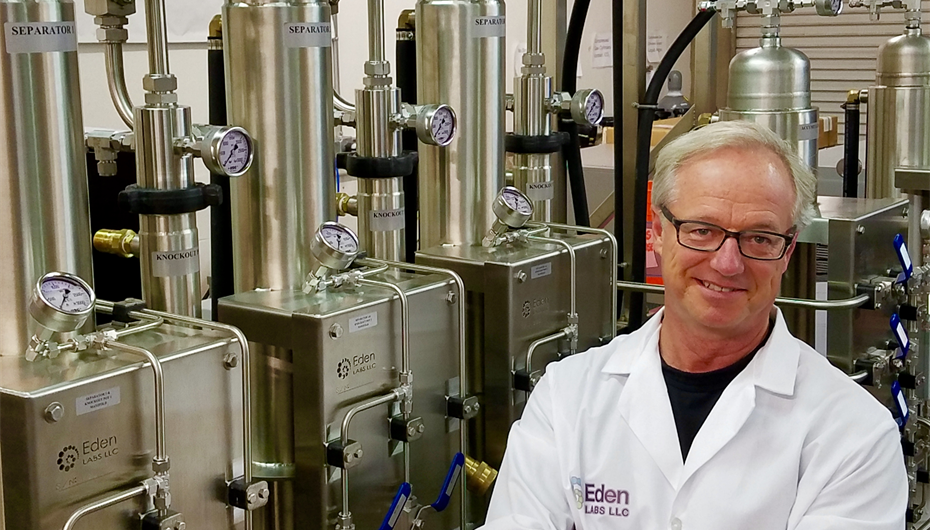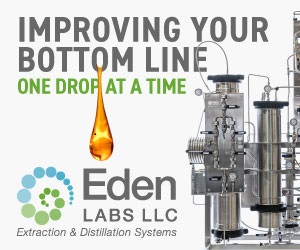Eden Labs’ Blog
Pumping Systems in CO2 Extraction:
Why and How to Evaluate Liquid, Gas Booster and Dual-pump
by Fritz Chess, Founder
CO2 Pumping Systems - Supercritical to Your Success.
When shopping for a supercritical CO2 extractor, the most important consideration is the pumping system of the extractor. This is the heart of the extractor which determines the rate and yield of oil that will be produced. Yet the pumping systems for CO2 extractors are plagued by design flaws and manufacturing mistakes. To make a wise investment in a CO2 extractor it is essential to understand the pumping system within the machine.
Evaluating Pumping Systems in CO2 Extraction
There are three basic pumping configurations used in CO2 extraction: liquid, gas booster, and dual- pumping. A liquid pump, pumps liquid CO2. A gas booster pumps gaseous CO2. In a dual-pump system, the liquid pump and gas booster are both used in the same extraction process. This article will explain how the three designs work and look at the pros and cons of both.
Gas Boosters: The Legacy CO2 Extraction Systems
The gas booster design was pioneered by Eden Labs in 2003. At the time, most closed-loop supercritical extractors used a dual-pump design. The gas booster design was conceived as a simpler way to recover and reuse the CO2.
Gas boosters pump vapors or gases that saturate the soluble material (such as cannabis, hops, coffee beans, etc.) to extract a desired product. In a closed-loop system vapors exit the separator after the extracted oil has been separated and flow directly to the inlet of the booster. From here they are pumped and compressed back into the extraction vessel to the higher pressures required for extraction.
In this system, CO2 is continuously compressed to a high pressure in the extractor vessel and depressurized to a vapor in the separator (to extract the oil). The vapor then enters a pump where the process is repeated.
Eden Labs offered this design from 2003 to 2012 with relative success depending on the botanical and the industry. Over time and especially starting in late 2009, Eden recognized several deficiencies with gas booster systems.
The Pros and Cons of Gas Booster Systems
Pros
The only advantage to the gas booster design is for the manufacturer of the system. Gas booster extractors are faster and less expensive to build than the other two designs. In the gas booster design, you don’t have to have a condensing mechanism that condenses the gas back into a liquid to go through the pump, which protects the pump from damage.
Cons
Gas boosters are slow. Pumping CO2 in vapor phase is inefficient because there is very little density to the CO2. Therefore it is difficult to move it in sufficient quantities for a fast, efficient extraction which leads to lengthy extraction run times.
Another major problem is that gas booster pumps are designed to pump pure gases. Filling scuba tanks with compressed air is a good example. When using them in an extractor there are always light, volatile oils - terpenes, which become entrained in the CO2 vapor and enter the pump. Once they are compressed and heated by the pump piston they carbonize and harden which causes them to damage the pump.
Yields tend to be lower with gas booster extractors as well. Although it is possible to get good yields, it is easy to make errors in which insufficient quantities of CO2 are being circulated in the system. Even though pressure and temperature gauges are reading the right numbers, the extractor vessel is not fully saturated with sub or supercritical CO2 resulting in low quantities of oil being recovered. Therefore to achieve a full extraction, the system must be run for extended periods for a full extraction, if this can be achieved at all.
Liquid Pumps: Superior Performance and Yield
It has been widely accepted in recent years by established, industrial manufacturers of CO2 extraction equipment that pumping liquid is the best way to design an SCFE extractor. This is how Eden Labs has been engineering supercritical CO2 systems since 2012. Eden recognized our clients were running their systems 24/7 and so we completely reengineered the gas booster system and produced the Hi-Flo line to reduce run times and increase yields putting our clients in the position to meet demand and lead markets.
With a liquid pumping system, cold, dense liquid CO2 is fed into the inlet of the pump. The compressed liquid goes from the outlet of the pump to a heat exchanger which sets the temperature of the extraction. The liquid CO2 then enters through the bottom of the extractor vessel where it thoroughly penetrates the material for extraction and begins dissolving the oils into solution.
Extraction pressure is determined by a regulator valve at the top of the separator. As the oil saturated CO2 passes through the valve, it de-pressurizes and flashes to gas which releases the oil to the bottom of the cool separator for collection. The CO2 vapor exits the separator and goes to a cold heat exchanger where it is condensed back to liquid. The liquid then flows into an accumulator where it is further cooled to a dense liquid. The colder and more dense the liquid is, the higher the flowrate. This is because each stroke of the pump moves more CO2 if it is cold and dense.
EDENLABS.COM/BLOG
The Pros and Cons of Liquid Pump Systems
Pros
The distinct advantages to liquid pumping are: faster extraction times, better yields, and higher quality extractions. In addition, the systems are far more reliable and work harder and longer with no interruption in production due to system frailty.
If the separators are designed properly, terpenes are retained for collection better than other designs because the higher pressure of the separators keeps the terpenes liquefied so they sink to the bottom of the separator for easy collection.
Unlike the lower pressures of a gas booster or dual-pump system terpenes are unable to re-enter the booster pump and severely damage it.
Cons
The dis“advantages are simply that these systems are more complicated and expensive to manufacture. There is no disadvantage to the end user who is running the equipment.
Faster extraction times, better yields, and higher quality extractions
Dual-pump CO2 Extraction Systems
The dual-pump system was designed and patented by a company called Critical Fluid Solutions in the 1980’s. Several variations of this design were used by various manufacturers of CO2 extraction equipment for many years. Ultimately the design was rejected by all major companies because of the vaporized terpenes which pass into the gas booster pump, shredding it and leading to constant maintenance issues.
In a curious development, several new startup CO2 extractor companies catering to the cannabis industry have revived this design in the last couple years. Touting it as a radical new invention, these companies have managed to convince many innocent investors that this is the best way to extract botanical oils with CO2.
The dual-pump concept is an awkward combination of liquid pumping and gas booster vapor recovery. A liquid pump pushes the CO2 through the extraction vessel just like a conventional liquid design. As the oil-saturated CO2 depressurizes and extracts the oil in the separator, the vapor then exits the separator and enters the gas booster just like in a conventional gas booster extractor. The booster compresses it back to liquid so it is ready to enter the inlet of the liquid pump. The compression and liquefaction of the CO2 is usually assisted by a chiller.
The False Benefits of Dual-pump Systems
On Stability. Both booster and liquid systems will operate with complete stability if engineered and operated properly.
On Temperature. It is true that the separators can be operated at lower temperatures - but this will have no effect on the extracted product in a properly designed system. A liquid system may have an outside heating jacket set at 140F, but the interior, extracted oil is sitting in a pool of cool, liquid CO2 in the bottom of the separator. Liquids can only be heated to their boiling point. More heat only makes them boil faster. So in a typical liquid system separator where the pressure is 900 psi and the temperature of the heating jacket is 140F, the boiling CO2 pool is only approx 60F. This is not a temperature that will overheat anything.
Some liquid designs on the market use separators which are too small and have too much heat on them. This results in a system lacking a pool of liquid CO2 in the bottom of the separator resulting in burnt oil. Eden Labs has carefully engineered the separators to operate at the correct parameters for highest quality oil yields.
On Energy Dual-pump systems use less energy than a liquid system to condense the CO2 vapor back to liquid. This minor advantage, however is greatly outweighed by the disadvantages and the related expenses of a dual-pump design.
The Problems with Dual-pump Systems
The pump is always the weak link in any system in which it is required. Pumps are far more likely to break than other parts within any piece of equipment. Having two pumps doubles the chances of equipment breakdown.
If there is a fluctuation in voltage the system’s stability is compromised. The two pumps must be kept in perfect flow rate balance meaning the liquid pump and the booster pump must be moving CO2 at the same rate. Voltage fluctuations will throw this rhythm off. Furthermore, the gas booster pump within this design is prone to the same problems as a single booster design as mentioned previously.
The Choice is Clear
In conclusion, a liquid pumping system is the proven, optimal way to engineer a supercritical CO2 extractor. All of the well established companies in the CO2 industry utilize a liquid pump system. Where one sees companies producing gas booster designs and dual-pump systems are new and less experienced extraction start-up companies in the cannabis market. It is a new and exciting market that feels like a gold rush. However, we know this equipment is the most important tool for your business. Don’t buy a shovel with a weak handle, a low quality blade or what is advertized as a shovel but really works like a spade. Know what you are buying and do your research, it is key to your success.
Prospective extractors looking to produce high-yields and avoid costly expenses related to maintenance and repair of CO2 extraction systems should evaluate liquid-pump designs.
For further evidence as to the complications of gas-booster and dual-pump design, seek out opinions from producers operating CO2 extraction systems over several years.
http://www.edenlabs.com EDENLABS.COM/BLOG
Register for FREE to comment or continue reading this article. Already registered? Login here.
1




